Talkdesk Embedded for Custom Integrations
Overview
This implementation, Talkdesk Embedded for Custom Integrations, is available on the Talkdesk CDN and can be embedded in any external system using an iframe (details below).
This document aims to present this solution and document the installation/integration process that will have to be carried out by the customer to get this solution up and running.
Customizing code to connect with Talkdesk Embedded
To facilitate this integration, we have created a demo that can be downloaded by executing the command:
curl -o https://prd-cdn-talkdesk.talkdesk.com/talkdesk-embedded/latest/demo-generic/index.html
To get started and write your own custom code, in the custom CRM it is necessary an iFrame. This iFrame will load the generic implementation from our CDN:
<iframe id="td-emb-container" title="Talkdesk Embedded" src="https://prd-cdn-talkdesk.talkdesk.com/talkdesk-embedded/latest/generic/index.html" allow="microphone *" frameborder="0"></iframe>
Communication between windows (iframe and the custom integration) is done using JavaScript events with Window.postMessage().
Then the following JavaScript is needed:
const sendEventToTD = (action, data) => {
let tdEmbContainer = document.getElementById('td-emb-container');
// Send event to TD Embedded iframe
tdEmbContainer.contentWindow.postMessage({
action,
data
}, tdEmbContainer.src);
}
const eventHandler = (event) => {
let tdEmbContainer = document.getElementById('td-emb-container');
// IMPORTANT: check the origin of the data!
// Validate if the events are coming from the TD Embedded iframe
if (event.origin != tdEmbContainer.src) {
return;
}
// The data was sent from your iframe.
// Data sent with postMessage is stored in event.data
console.log("### [custom integration] <<< event received:", event);
// NOTE: Write your custom code to handle the events here
};
window.onload = () => {
// Event handler
window.addEventListener('message', eventHandler);
// Init
sendEventToTD('init_td_embedded', {
url: window.location.origin,
int: 'custom-integration',
env: 'prd-us',
aid: 'agent-id-123',
view: 'headless',
app: 'conversation'
show_cti_status: ‘true’
});
// Example of how click to call can be implemented
// Bind click to call function
document.getElementById("click-to-call-btn").onclick = () => {
const input = document.getElementById('click-to-call-input')
if (input && input.value && input.value.length !== 0) {
sendEventToTD('clickToCall', {
to: input.value
});
}
};
}
The integration starts with the window.onload() function.
First, we define the event handler for messages sent by the Talkdesk Embedded iFrame we've just embedded - more details on incoming events can be found below.
Next, we need to initialize the Talkdesk Embedded solution by sending it the following message:
This step is mandatory to start the solution, otherwise, only a blank screen will be displayed.
{
'action': 'init_td_embedded',
'data': {
url: window.location.origin, // the url of the current window - the window that will receive the events from the iframe
int: < name_of_your_custom_integration >,
env: < prd-us | prd-ca | prd-eu | prd-au >,
aid: < agent_crm_id >, // talkdesk agent external id
view: < external | workspace | headless >,
app: < conversation | agent-assist | live | canvas-embedded ... > // if the view is headless, this parameter is the app that will be loaded in headless mode
show_cti_status: <true | false> // controls visibility of bar indicating cti status in the selected app
renderMode: < host | renderer > // if the view is workspace or the app is conversation, this parameter controls the multi-render experience
}
}
Note
To have the CTI Connected, the aid parameter needs to be the same as the agent id sent in agent sync.
The renderMode parameter allows configuring the multi-render experience to navigate between multiple tabs within a third-party system with the Conversations App embedded without disrupting the active session. This parameter is only necessary to be defined for Workspace and Conversation app if you desire to enable the multi-render experience.
To make it easier to send messages to the iframe, an auxiliary function has been created: sendEventToTD. This function receives the action and data as parameters and sends an event (using Window.postMessage()) to the contentWindow of the iframe.
The third part of the on-load function only shows how the onclick of a button can be defined to call the CTI click-to-call functionality, the rest of the example can be found in the demo.
Event handler: Messages published by the Talkdesk embedded
The event handler mentioned above will be responsible for handling messages sent by the iframe. All the events that the Talkdesk Embedded solution propagates are the same as those emitted by the CTI.
The following table describes all messages that can be used with the Talkdesk Embedded and required responses.
| Actions | Data | Description |
|---|---|---|
| login | N/A | This message is sent after login in the CTI |
| logout / userLogoutForced | N/A | This message is sent after logout from the CTI |
| hide | N/A | This message is used to hide the Talkdesk Embedded / CTI |
| show | N/A | This message is used to show the Talkdesk Embedded / CTI |
| popover | N/A | This message is sent by conversation app when a call is ringing, and is used to show Talkdesk Embedded / Conversation app |
| openContact | { action: 'openContact', data: { externalId: \<contact_crm_id> } } | This message is used by CTI to request the Custom CRM to open a contact form action: Used to identify the message type. data: The data received from Talkdesk Workspace. externalId: The external contact id |
| sendData | { action: 'sendData', data: { custom-key: <custom-value>, custom-key2: <custom-value2>, } } | This message is sent by CTI when an automation is configured on Automation Tools. action: Used to identify the message type. data: Custom object defined on Automation Tools. |
| agentStatusChanged | `{ action: 'agentStatusChanged', data: { status: 'available' } } | This message is used to notify that the user status has changed in Talkdesk |
Messages that can be sent to the Talkdesk Embedded iframe
| Action | Data | Description |
|---|---|---|
| clickToCall | { action: 'clickToCall', data: { to: '+351123456789', contactId: \<contact_crm_id>, from: '+197863458768',metadata: { foo: 'bar'} }} | This message is used by Custom CRM to initialize a call in Talkdesk Workspace action: Used to identify the message type to: The number of the contact that we pretend to call to. contactId: OPTIONAL The external contact id. from: OPTIONAL Talkdesk number used as outbound caller |
| integrationStatusChanged | { "action": "integrationStatusChanged", "status": <STATUS> } | This message is used by the Custom CRM to update the agent status in Talkdesk. action: Used to identify the message type status: The Talkdesk status to update The possible status mappings are presented in the table below. |
| Status in Talkdesk | Sent status in the Event |
|---|---|
| available | available |
| away | away |
| offline | offline |
| busy | on a call |
| busy_<custom-status-name> | Custom busy status on Talkdesk |
| away_<custom-status-name> | Custom away status on Talkdesk |
Note
It is possible to send additional metadata in the Click-To-Call action. Using a key value approach. All the keys sent in metadata object will be interpreted as studio context variables and be available to be used later on in automations platform.
Screenshots
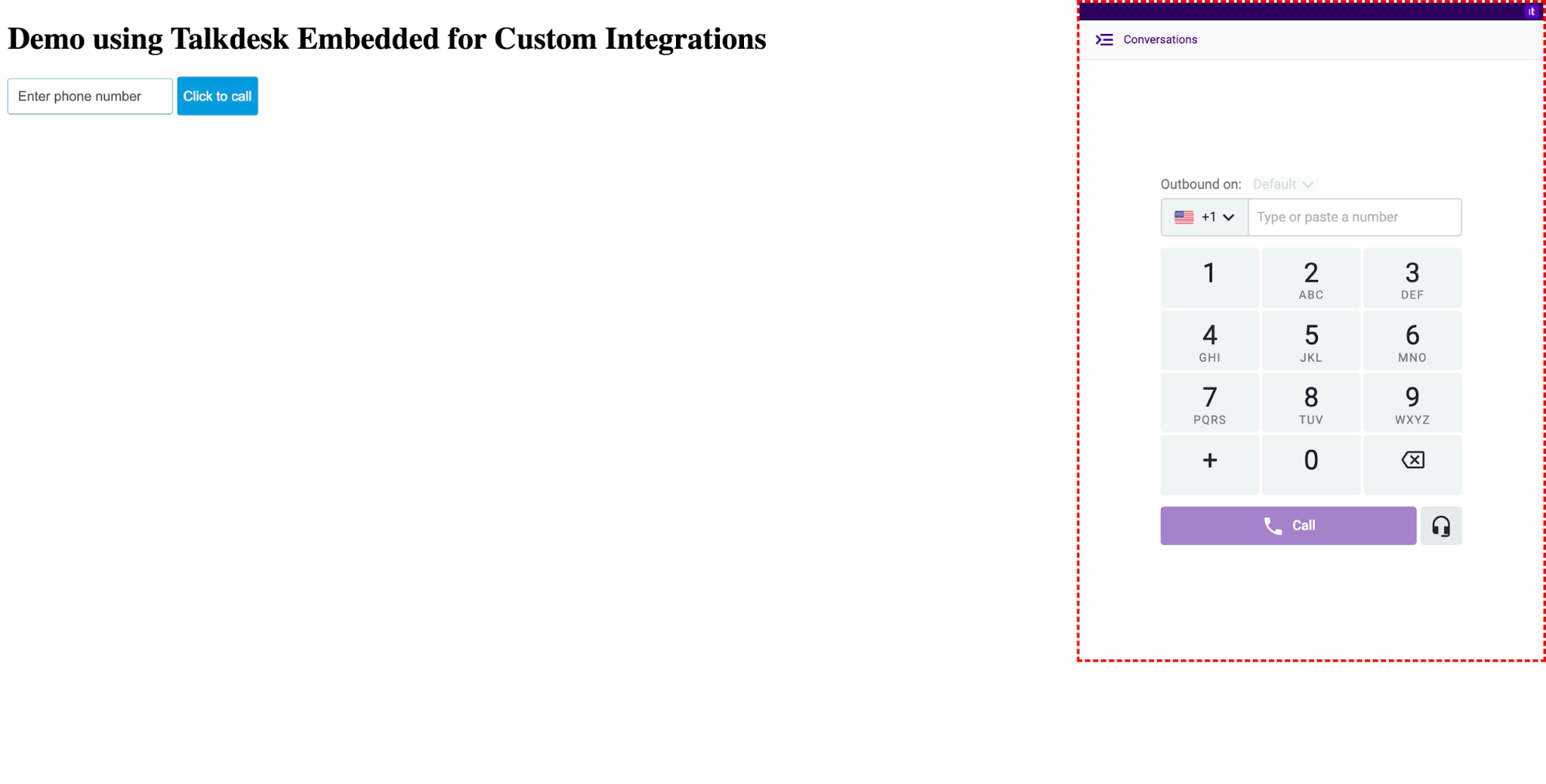
Talkdesk Embedded - External configuration
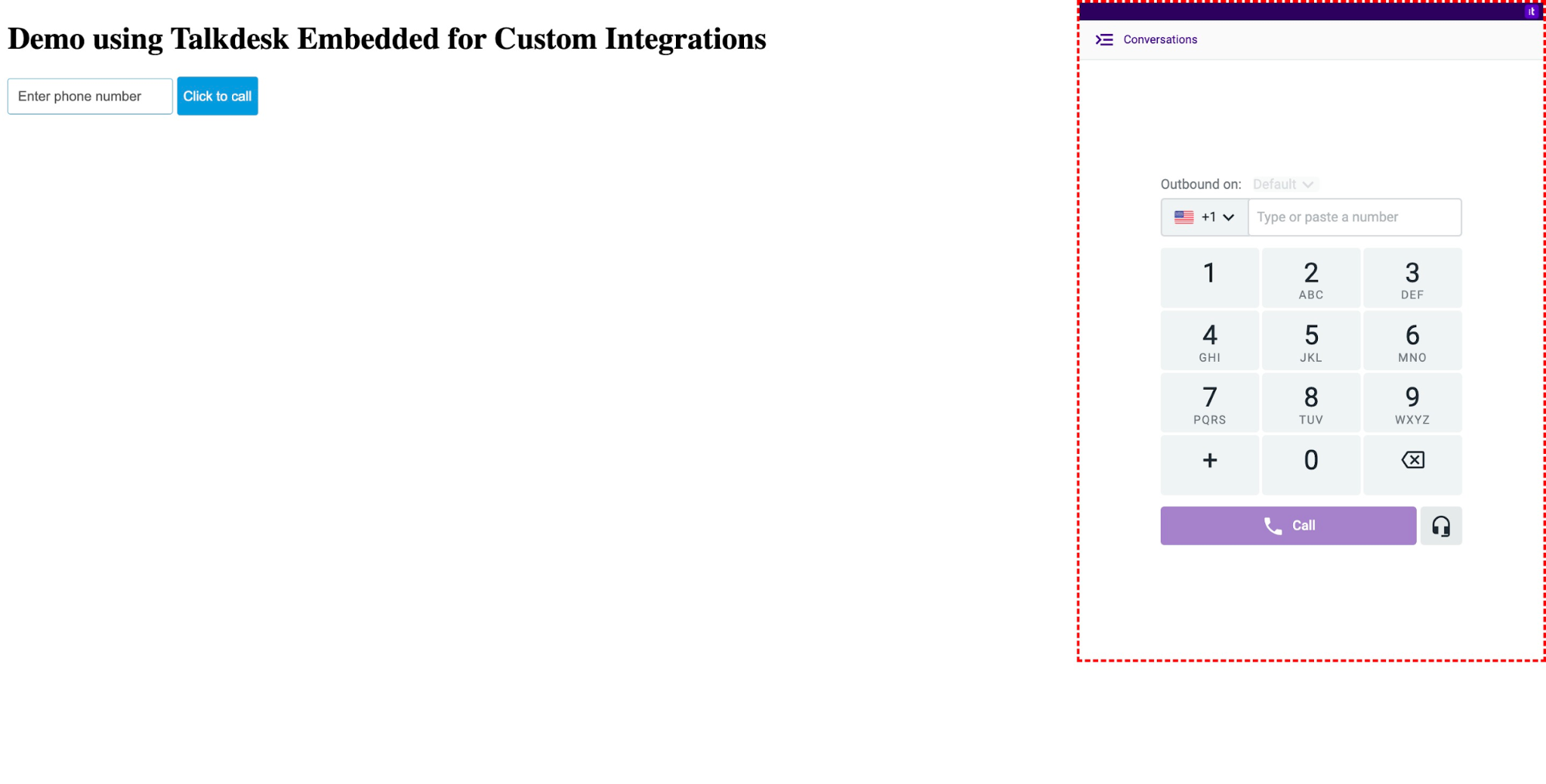
Talkdesk Embedded - Headless configuration with Conversations app and CTI Status bar visible.
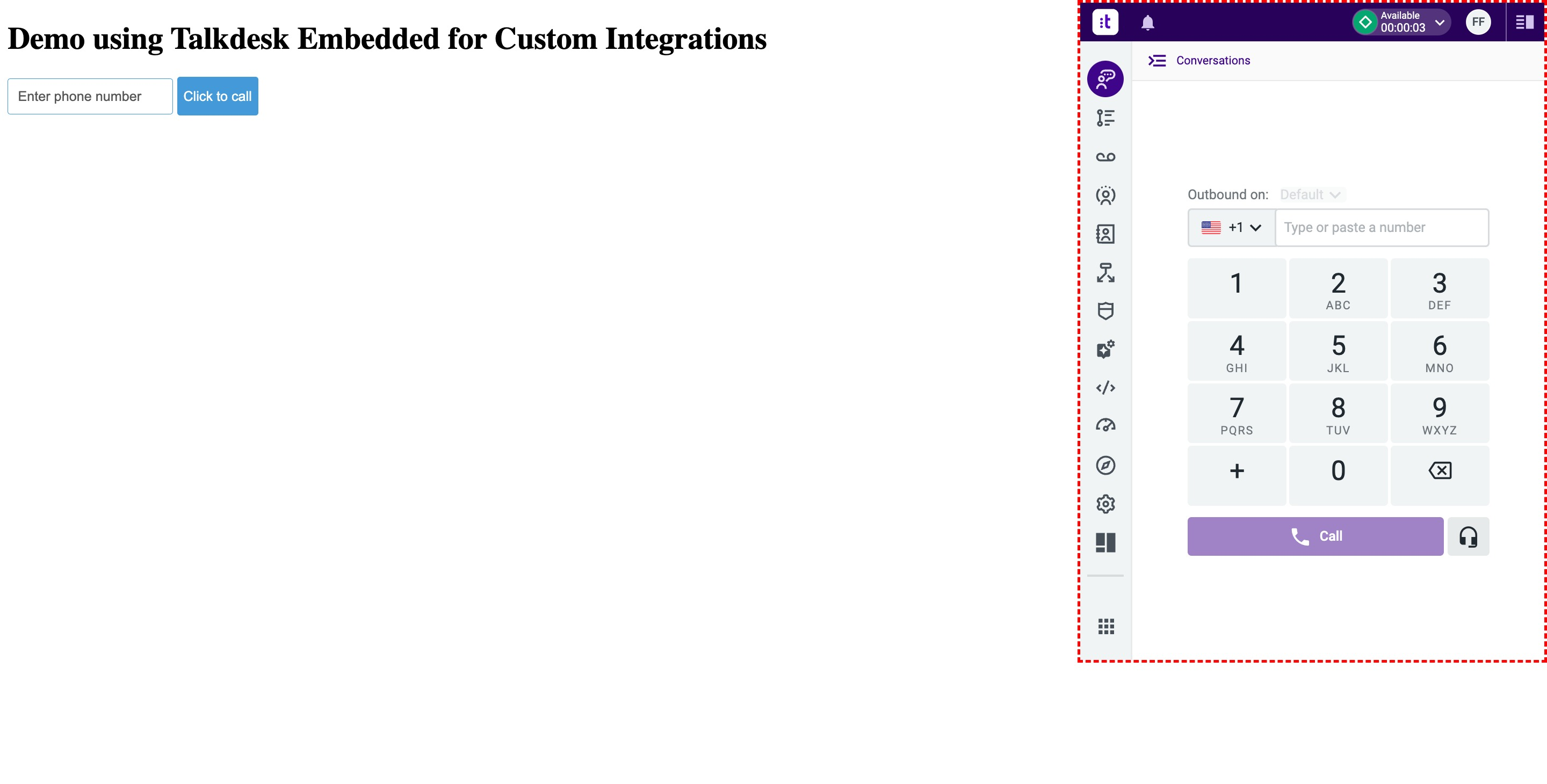
Talkdesk Embedded - Workspace configuration
Support and Troubleshooting
CTI Disconnected
Please follow the steps below and make sure agents have Conversations open at least in one tab or have Conversations/Workspace Embedded, since a Conversations session is required.
Then to have CTI Connected agents must:
- Have the Client Integration configured on the Talkdesk User settings;
- Send to Talkdesk the agent id and email on Agent Sync process.

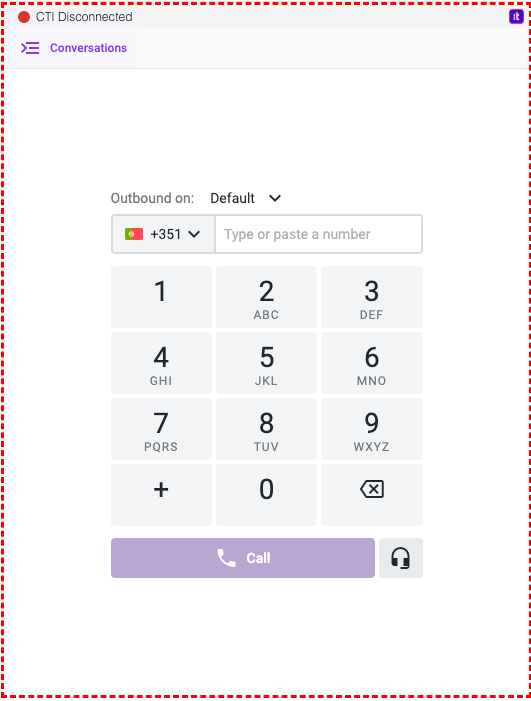
Embedded Logs
We can use the Browser Dev Tools Console to inspect the events being exchanged between the systems. All logs related to this solution start with the following prefix: ###.
Note
if logs show any event not mentioned in the table above, this is because all events issued by CTI are propagated by Talkdesk Embedded to the integration.
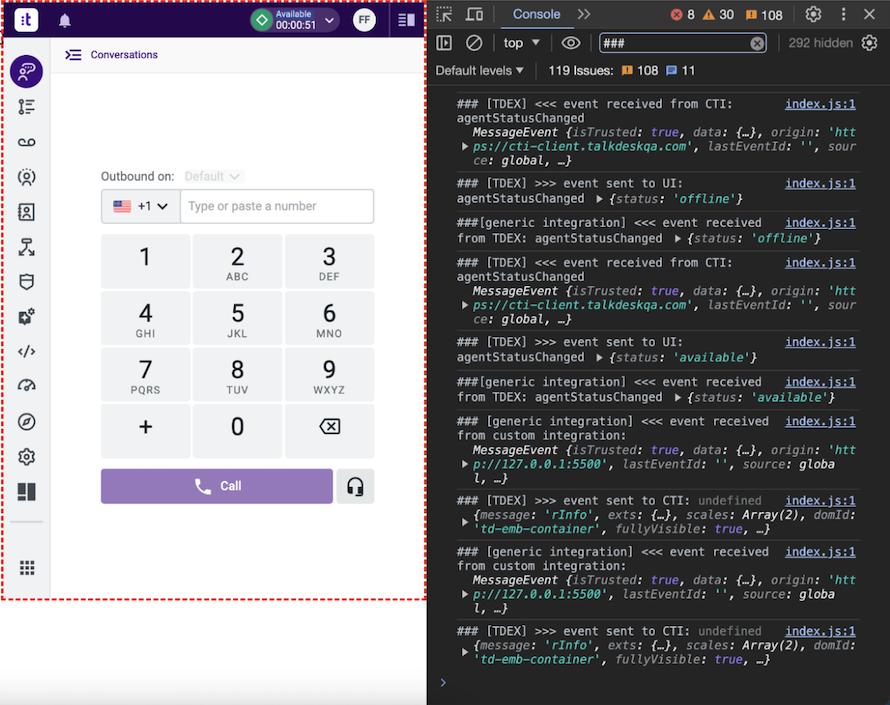
Events not received on CRM / Talkdesk
When the CTI is disconnected agents will not receive events from Talkdesk and Talkdesk will not receive events from the CRM.
Using Browser Dev Tools Console and searching for init event received we confirm the values sent on the init_td_embedded event:
- The parameter int must match the agent Client Integration configured on the Talkdesk User settings;
- The parameter aid be the same as the
idsent on Agent Sync; - The parameter env must match the Talkdesk account region
prd-us | prd-ca | prd-eu | prd-au.

Updated 5 months ago